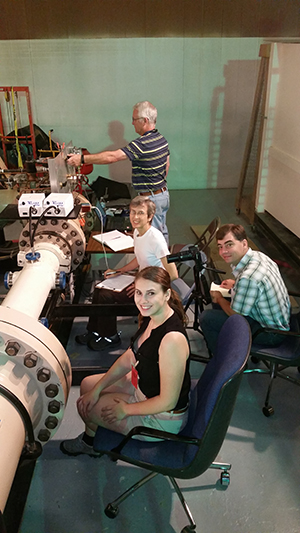 My name is Emily Nield and I’m a geology graduate student at the University of Tennessee where I study planetary aeolian (wind) geomorphology. In our solar system, we have observed wind activity on Earth, Mars, Venus, and on Saturn’s moon Titan. It’s important to study how the wind shapes these planetary bodies because this study provides a direct link between the atmosphere and the surface, providing crucial clues to help us understand the current and past atmospheric conditions on these bodies.
My name is Emily Nield and I’m a geology graduate student at the University of Tennessee where I study planetary aeolian (wind) geomorphology. In our solar system, we have observed wind activity on Earth, Mars, Venus, and on Saturn’s moon Titan. It’s important to study how the wind shapes these planetary bodies because this study provides a direct link between the atmosphere and the surface, providing crucial clues to help us understand the current and past atmospheric conditions on these bodies.
Earth has an atmospheric pressure of 1 bar. Venus and Titan have atmospheric pressures greater than Earth’s. Titan is 1.5 times larger, and Venus is 90 times larger. On Earth, we understand how sand or sediment is moved by air and by water. But the atmosphere on places like Titan and Venus are very thick. The air that blows on these bodies is thicker than the air on Earth, but it’s still thinner than liquid water. It’s an in between stage, and we know very little about how sediment moves under these conditions. The goal of my research is to study how sediment is lifted off the surface by the wind on planetary bodies with thick atmospheres.
I conduct my research at the Planetary Aeolian Laboratory, at NASA Ames Research Centre, located in Mountain View, California. I use the Titan Wind Tunnel, the only high-pressure wind tunnel in the world that can move sediment, at this facility to run my experiments. I place a bed of sediment in the test section of the tunnel. The tunnel is then turned on and I can control the speed of the wind along with the air pressure inside the tunnel and take close-up videos to observe how the sediments move along the bed under these conditions.
To learn more about my research visit my YouTube Channel.
https://www.youtube.com/watch?v=VZhP9lQvaV4
PDS4 Aeolian Threshold Speed Archive
In addition to my research, I am currently establishing an archive of experimentally derived threshold wind speed speed data. The purpose of this work is to increase the amount and quality of aeolian threshold wind speed data available to the community. We will do this by creating a publicly available archive of threshold speed data, hosted by the NASA Planetary Data System (PDS) Atmospheres Node. With contributions from the community, the aim of the archive is to preserve all past, current, and future data from thresh-old experiments. Researchers can use it as part of their Data Management Plan for projects funded by NASA.
Watch this video to learn more about the archive:
https://www.youtube.com/watch?v=E_fPJRO19PY
Conference Abstracts
- Nield, E. V., D. M. Burr, J. P. Emery, S. L. F. Sutton, J. F. Kok, and J. K. Smith (2018) The effect of density ratio on saltation threshold: Rederiving the curve. 67th GSA Southeastern section, Knoxville, TN, Apr 12-13, Abstract 5-10.
- Nield, E. V., D. M. Burr, J. P. Emery, S. L. F. Sutton, J. F. Kok, and J. K. Smith (2018) A wind tunnel study of the effect of density ratio on saltation threshold conditions. Lunar Planet. Sci. XLIX, The Woodlands, TX, Mar 19-23, Abstract 2141.
- Nield, E. V., D. M. Burr, and L. D. V. Neakrase (2018) Archiving experimentally derived threshold wind speed data in PDS4. Lunar Planet. Sci. XLIX, The Woodlands, TX, Mar 19-23, Abstract 2106.
- Runyon, K. D., D. M. Burr, J. P. Emery, S. L. F. Sutton, E. V. Nield, and J. K. Smith (2018) Titan’s aeolian saltation threshold conditions: Initial results. Lunar Planet. Sci. XLIX, The Woodlands, TX, Mar 19-23, Abstract 1291.
- Nield, E.V, D. M. Burr, and L.D. V. Neakrase (2017) Archiving experimentally derived threshold wind speed data in PDS4. Fifth Intl Planetary Dunes Workshop, St George, UT, May 16-19, Abstract 3014.
- Sutton, S. L. F., E. V. Nield, D. M. Burr, N. T. Bridges, J. K. Smith, J.F. Kok, F.A. Turney, J. R. Marshall (2017) Towards a classification scheme for aeolian fluid ejection: observations during high-pressure wind tunnel experiments. Fifth Intl Planetary Dunes Workshop, St George, UT, May 16-19, Abstract 3040.
- Burr, D.M, E. V. Nield, and L. D. V. Neakrase (2016) A community archive of threshold (minimum) wind speed data from wind tunnel experiments: Initiation of an aeolian data archive. 47th Lunar and Planetary Science Conference, Woodlands, TX, March 21-25, Abstract 1047.
- Nield, E. V, D. M. Burr, N.T. Bridges, J. K. Smith, J. P. Emery, and J.R. Marshall. (2016) A wind tunnel study of the effect of pressure on saltation threshold conditions. 47th Lunar and Planetary Science Conference, Woodlands, TX, March 21-25, Abstract 1028.